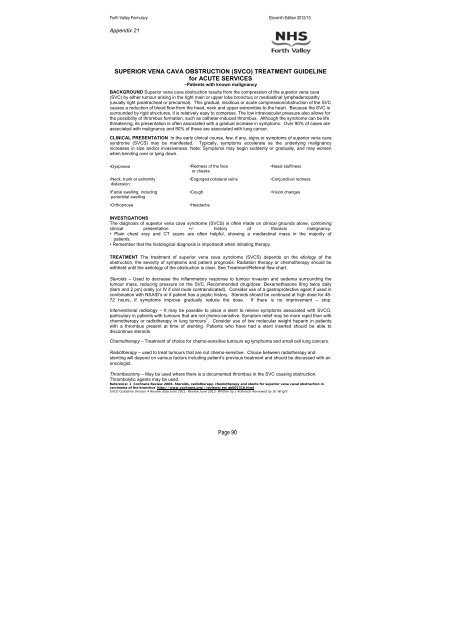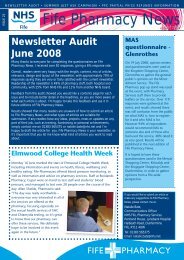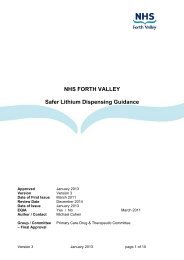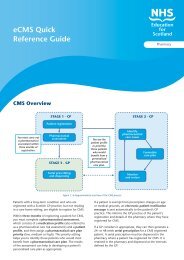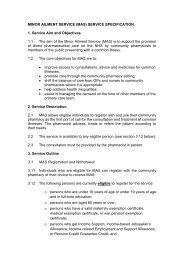nhs forth valley formulary 11 - Community Pharmacy
nhs forth valley formulary 11 - Community Pharmacy
nhs forth valley formulary 11 - Community Pharmacy
You also want an ePaper? Increase the reach of your titles
YUMPU automatically turns print PDFs into web optimized ePapers that Google loves.
Forth Valley Formulary Eleventh Edition 2012/13Appendix 21SUPERIOR VENA CAVA OBSTRUCTION (SVCO) TREATMENT GUIDELINEfor ACUTE SERVICES–Patients with known malignancyBACKGROUND Superior vena cava obstruction results from the compression of the superior vena cava(SVC) by either tumour arising in the right main or upper lobe bronchus or mediastinal lymphadenopathy(usually right paratracheal or precarinal). This gradual, insidious or acute compression/obstruction of the SVCcauses a reduction of blood flow from the head, neck and upper extremities to the heart. Because the SVC issurrounded by rigid structures, it is relatively easy to compress. The low intravascular pressure also allows <strong>forth</strong>e possibility of thrombus formation, such as catheter-induced thrombus. Although the syndrome can be lifethreatening, its presentation is often associated with a gradual increase in symptoms. Over 90% of cases areassociated with malignancy and 80% of these are associated with lung cancer.CLINICAL PRESENTATION In the early clinical course, few, if any, signs or symptoms of superior vena cavasyndrome (SVCS) may be manifested. Typically, symptoms accelerate as the underlying malignancyincreases in size and/or invasiveness. Note: Symptoms may begin suddenly or gradually, and may worsenwhen bending over or lying down.•Dyspnoea•Neck, trunk or extremitydistension.•Facial swelling, includingperiorbital swelling•Orthopnoea•Redness of the faceor cheeks•Engorged collateral veins•Cough•Headache•Nasal stuffiness•Conjunctival redness•Vision changesINVESTIGATIONSThe diagnosis of superior vena cava syndrome (SVCS) is often made on clinical grounds alone, combiningclinical presentation +/- history of thoracic malignancy.• Plain chest xray and CT scans are often helpful, showing a mediastinal mass in the majority ofpatients.• Remember that the histological diagnosis is importandt when initiating therapy.TREATMENT The treatment of superior vena cava syndrome (SVCS) depends on the etiology of theobstruction, the severity of symptoms and patient prognosis. Radiation therapy or chemotherapy should bewithheld until the aetiology of the obstruction is clear. See Treatment/Referral flow chart.Steroids – Used to decrease the inflammatory response to tumour invasion and oedema surrounding thetumour mass, reducing pressure on the SVC. Recommended drug/dose: Dexamethasone 8mg twice daily(8am and 2 pm) orally (or IV if oral route contraindicated). Consider use of a gastroprotective agent if used incombination with NSAID’s or if patient has a peptic history. Steroids should be continued at high dose for 48-72 hours, if symptoms improve gradually reduce the dose. If there is no improvement – stop.Interventional radiology – It may be possible to place a stent to relieve symptoms associated with SVCO,particulary in patients with tumours that are not chemo-sensitive. Symptom relief may be more rapid than withchemotherapy or radiotherapy in lung tumours 1 . Consider use of low molecular weight heparin in patientswith a thrombus present at time of stenting. Patients who have had a stent inserted should be able todiscontinue steroids.Chemotherapy – Treatment of choice for chemo-sensitive tumours eg lymphoma and small cell lung cancers.Radiotherapy – used to treat tumours that are not chemo-sensitive. Choice between radiotherapy andstenting will depend on various factors including patient’s previous treatment and should be discussed with anoncologist.Thrombectomy – May be used where there is a documented thrombus in the SVC causing obstruction.Thrombolytic agents may be used.Reference: 1 Cochrane Review 2006. Steroids, radiotherapy, chemotherapy and stents for superior vena caval obstruction incarcinoma of the bronchus http://www.cochrane.org//reviews/en/ab001316.htmlSVCO Guideline Version 4 Review date June 20<strong>11</strong>. Review June 2013. Written by J Robinson Reviewed by Dr.WrightPage 90


